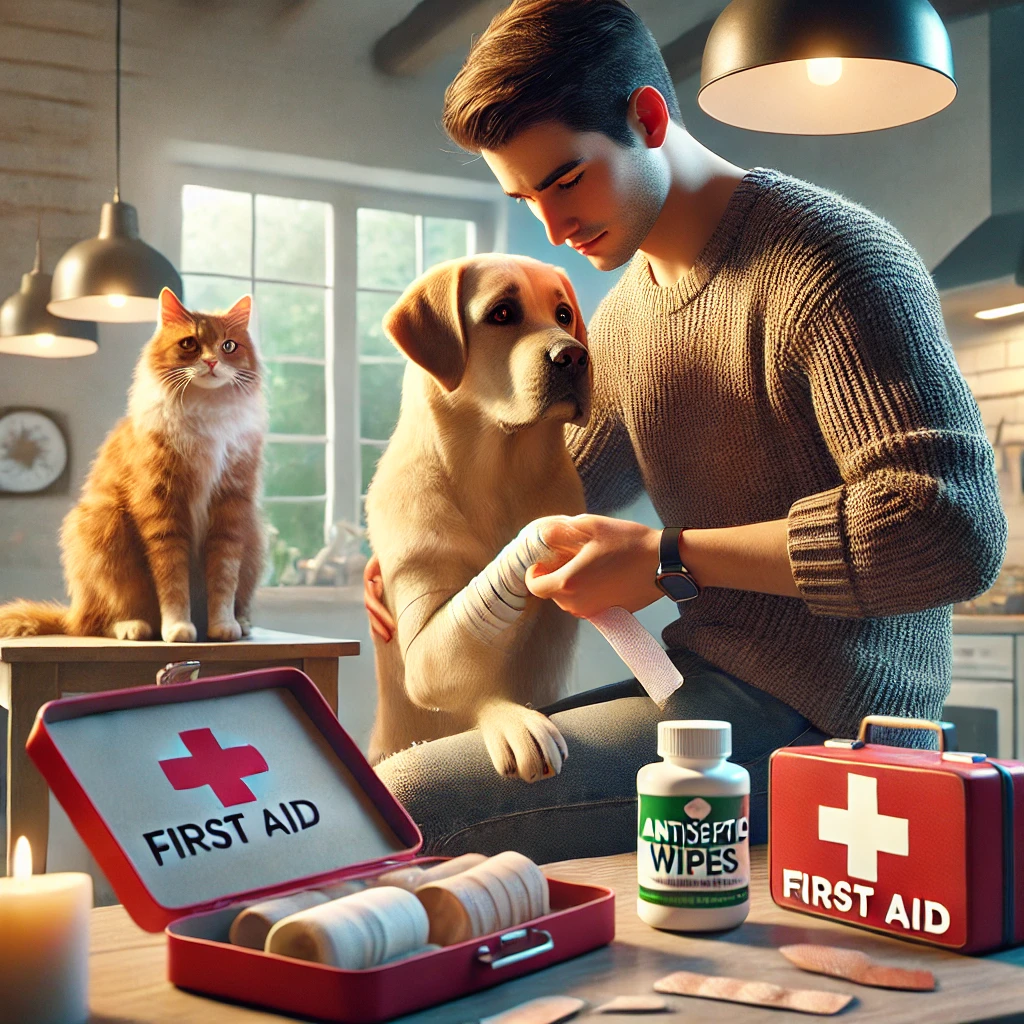
Animal First Aid: What Every Pet Owner Should Know
As pet owners, we do everything we can to keep our furry friends safe and healthy. But accidents and emergencies can happen anytime. Knowing animal first aid can make all the difference in those crucial moments before you get professional veterinary care.
From treating minor cuts to handling more serious situations like choking or poisoning, this guide will give you essential animal first aid knowledge to help your pet in an emergency.
1. Create a Pet First Aid Kit
Just like humans, pets need their own first aid kit stocked with essentials. Here’s what every pet owner should have on hand:
🩹 Basic supplies: Sterile gauze, adhesive tape, cotton balls, antiseptic wipes, and a digital thermometer.
💊 Medications: Hydrogen peroxide (for inducing vomiting under vet guidance), activated charcoal (for toxin absorption), and pet-safe pain relievers.
✂️ Tools: Tweezers (for removing splinters or ticks), blunt-end scissors, disposable gloves, and a flashlight.
📞 Emergency contacts: Your vet’s number, a 24-hour emergency animal clinic, and a pet poison control helpline.
🔹 Pro Tip: Store your pet first aid kit in an easily accessible place and check it regularly to replace expired items.
2. Treating Cuts, Scrapes, and Wounds
Pets are naturally curious, and sometimes, that curiosity leads to minor injuries. If your pet gets a small cut or scrape:
✅ Clean the wound with warm water and mild soap.
✅ Apply an antiseptic (like chlorhexidine) to prevent infection.
✅ Cover the wound with sterile gauze and bandage if needed.
🚨 When to See a Vet:
- If the wound is deep or bleeding excessively.
- If there’s swelling, redness, or pus, which could indicate an infection.
🔹 Pro Tip: Never use hydrogen peroxide on wounds—it can delay healing. Stick to pet-safe antiseptics.
3. What to Do If Your Pet Is Choking
Choking is one of the scariest emergencies pet owners can face. Common causes include small bones, toys, or food lodged in the throat. If your pet is choking:
🐶 Signs of choking: Pawing at the mouth, difficulty breathing, excessive drooling, or making gagging noises.
What to Do:
1️⃣ Check the mouth: If you see an object, gently try to remove it using tweezers.
2️⃣ Perform the Heimlich maneuver:
- For small pets: Hold them with their back against your chest and apply quick, firm thrusts just below their ribcage.
- For large dogs: Stand behind them and apply abdominal thrusts by placing your hands just above their belly button and pushing firmly.
3️⃣ If they stop breathing, perform CPR (see next section).
🚨 When to See a Vet: Even if you remove the object, take your pet to the vet to check for internal injuries.
4. How to Perform CPR on Pets
If your pet stops breathing, knowing how to perform CPR could save their life.
💓 Steps for Pet CPR:
1️⃣ Check for breathing: Place your hand on their chest—if there’s no movement, proceed.
2️⃣ Lay them on their right side: This gives better access to the heart.
3️⃣ Chest compressions:
- For small pets: Use two fingers to compress the chest about 1 inch deep.
- For medium to large pets: Use both hands, pushing about ⅓ to ½ of their chest width.
- Perform 100-120 compressions per minute.
4️⃣ Rescue breaths: - Close their mouth and gently blow into their nose every 30 compressions.
5️⃣ Continue until they breathe or reach a vet.
🚨 When to See a Vet: Even if CPR revives them, get immediate veterinary care to assess any damage.
5. Handling Poisoning or Toxin Exposure
Pets are curious by nature, and sometimes they ingest things they shouldn’t. Common household toxins include:
🚫 Chocolate, xylitol (found in sugar-free gum), grapes/raisins, onions, antifreeze, human medications, and certain plants.
🐶 Signs of poisoning: Vomiting, drooling, lethargy, seizures, or difficulty breathing.
What to Do:
✅ Call your vet or a pet poison control hotline immediately.
✅ If instructed by a vet, induce vomiting using hydrogen peroxide (1 teaspoon per 5 lbs of body weight).
✅ Do NOT induce vomiting if the substance is caustic (e.g., bleach or batteries).
🚨 When to See a Vet: If you suspect poisoning, get professional help immediately—some toxins act fast.
6. Treating Burns and Heatstroke
🔥 Burns: If your pet suffers a burn from hot surfaces or chemicals:
- Flush the area with cool water (not ice!).
- Apply a pet-safe burn ointment.
- Cover lightly with a bandage and seek vet care for severe burns.
🌡️ Heatstroke: Overheating can be life-threatening, especially for brachycephalic breeds like Bulldogs and Pugs.
🐾 Signs of heatstroke: Excessive panting, drooling, red gums, vomiting, or collapse.
What to Do:
✅ Move them to a cool area immediately.
✅ Offer cool (not ice-cold) water.
✅ Apply cool, damp towels to their paws and belly.
✅ Get to a vet ASAP—heatstroke can cause organ failure.
7. Preventing Common Pet Emergencies
While knowing animal first aid is crucial, prevention is the best medicine!
✔️ Keep harmful foods and chemicals out of reach.
✔️ Use pet-safe toys to prevent choking hazards.
✔️ Check your yard for toxic plants.
✔️ Supervise pets near water to avoid drowning risks.
✔️ Regular vet checkups can catch health issues early.
Be Prepared, Stay Calm
Emergencies are stressful, but being prepared with animal first aid knowledge can help you react quickly and confidently. Every second counts in an emergency, and your actions could save your pet’s life.
💬 Do you have a pet first aid kit at home? Share your thoughts and experiences in the comments below!
